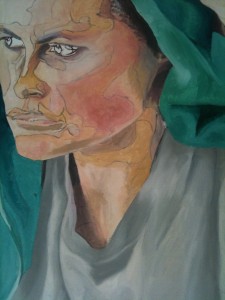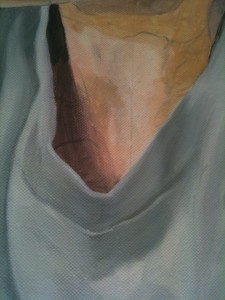|
If I had not kept track through my blog, I would not know how many days had gone into this painting already. That is a definite area where I can improve things. I have an idea of the software I can used for tracking the work in artwork, which is a multi-threading storyboard writer, free and open source. I think that keeping text notes on each painting in progress should be enough.
 The painting for today was almost entirely tonal. I was wearing a white T-shirt in the photograph, and it has picked up some colour, but this was all about form. This was the closest thing I have on this painting to a greyscale area. The painting for today was almost entirely tonal. I was wearing a white T-shirt in the photograph, and it has picked up some colour, but this was all about form. This was the closest thing I have on this painting to a greyscale area.
I started on the collar, where there was a very dark bit of skin, and the rest was material. Immediately, I made the grey too deep. The material is white cotton, and this looks like something grey. I was trying to avoid having big flat areas of undetailed white, but I went too far. The dark area under the towel is fine, but the rest should have lightened up. A grey T-shirt works visually, and I may alter the end colour a little for the composition, but the reference material is white, and altering it on the fly to something much darker is not easy.
As I put the paint on, it covered the dark lines far more thickly than the skin tones, so I made sure to cover them all, and worked with more paint than I had on the skin. The end result was something closer to how the finished surface may be:
 The contour lines of the face are now jarring to look at, but there are other things to do before fixing it. The tones, on the other hand, are pleasant, warmish, skin-ish, and have a good sense of moulding to them. They change somewhat as they go around corners, and there are no jarring areas, but they are far from complete, and they have white space in. The T-shirt, on the other hand, has only one more layer to go, if nothing goes awry. The contour lines of the face are now jarring to look at, but there are other things to do before fixing it. The tones, on the other hand, are pleasant, warmish, skin-ish, and have a good sense of moulding to them. They change somewhat as they go around corners, and there are no jarring areas, but they are far from complete, and they have white space in. The T-shirt, on the other hand, has only one more layer to go, if nothing goes awry.
I want to finish off the face in about one more layer (after the white parts are complete). This may be unrealistic, but if I push for it I will get far further than if I am tentative.
With the white staring eyes and no definition on the mouth, the piece looks spooky. Because I can read my own expression and recall what it was when I had the photo taken, I know it should not end up like that, but it is a comment I have right now from everyone who views it. I will find out if they are right later on.
Meanwhile, the full WiP shot:
 Click through for a somewhat bigger version of the picture, if you want to follow along in detail. The far shoulder was closer to the light source than the near one, and it wrinkled up more. As a consequence, the painting of it is not right – it needs to be cooler in tone, which will help it to retreat. It also needs to be less defined, or it stands out, and that brings it forward. Click through for a somewhat bigger version of the picture, if you want to follow along in detail. The far shoulder was closer to the light source than the near one, and it wrinkled up more. As a consequence, the painting of it is not right – it needs to be cooler in tone, which will help it to retreat. It also needs to be less defined, or it stands out, and that brings it forward.
At one point, I started to hate and disbelieve in the drapery, which I have come to believe is a good sign. It generally presages a good result in the near future, but I had never had it happen over one aspect of the painting; usually it is the whole thing that gives me the impression. My thought process goes something like:
- You are doing the wrong thing!
- You should be better at this!
- You are a talentless hack and should take up work flipping burgers!
- Wait, that bit there is not bad…
- I am a sodding genius!
- Wait. That is imperfect.
- See item 1
Outthinking my brain to get to where I want to be is a common habit for me, and the rollercoaster of confidence and terror is one that I am learning to ride. Keeping on painting during the self-doubt and not expecting everything to be great all the time is important in producing not just good pieces, but enough of them to make a living.
In this particular case I did not trust the moulding of the clothing around the front of the neck, and so I took it a bit further on, adding detail. What I ended up with is currently my favourite part of the painting:
 So there. See item 5. So there. See item 5.
|